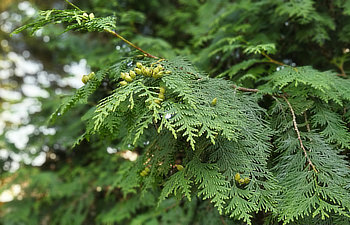
Tree trimming is a necessary part of maintaining your landscape, but many homeowners often wonder what to do with the resulting branches and clippings. Instead of discarding these useful materials, there are several eco-friendly and innovative ways to repurpose tree trimmings in your garden. Green Landscape Supply near Atlanta explores four practical ideas, and we have the landscape materials and building materials you need to do the job right.
1. Composting Tree Trimmings
Composting is one of the best ways to recycle organic materials, including tree trimmings. By turning these yard waste materials into nutrient-rich compost, you can enhance your garden soil and promote healthier plant growth.
- Chop or Shred Trimmings: To accelerate the decomposition process, it’s helpful to chop or shred larger branches into smaller pieces. This increases the surface area, allowing microorganisms to break down the material more efficiently.
- Combine with Other Organic Materials: For effective composting, mix your tree trimmings with a variety of other organic waste. Grass clippings, leaves and kitchen scraps (like vegetable peels and coffee grounds) work well. This combination ensures a balanced mix of carbon-rich browns (like wood chips) and nitrogen-rich greens (like food scraps), resulting in faster decomposition.
- Proper Aeration and Moisture: To maintain optimal composting conditions, it’s essential to ensure that the compost pile is properly aerated and retains adequate moisture. Turn the pile regularly to introduce air and monitor humidity levels—your compost should be damp like a sponge but not waterlogged. This balanced maintenance will accelerate the composting process and reduce odor.
2. Building Raised Garden Beds or Mounds
Tree trimmings can serve as excellent foundational material when building raised garden beds or planting mounds. Here’s how:
- Build Your Beds: Line or construct your raised garden beds with landscape timbers or stone for a strong, rustic appearance that lasts.
- Base Layer Foundation: Use larger branches and limbs as a base layer for your raised garden beds. This practice helps improve drainage, retain moisture and provide nutrients as the wood decays over time. Place the branches at the bottom of the bed, then layer with soil and compost for optimal growing conditions.
- Energy-Efficient: Constructing raised beds using tree trimmings is also energy-efficient, as it reduces the need to fill the entire bed with costly soil. Over time, as the wood decomposes and breaks down, it enriches the soil, contributing to a sustainable garden ecosystem.
3. Creating a Natural Border
Using tree trimmings to create natural borders or edging for garden beds provides both aesthetic appeal and practical benefits:
- Visual Appeal: A natural border made from branches can give your garden beds a rustic and organic look. It integrates seamlessly with the landscape, enhancing the overall design of your yard.
- Weed Control: Branches can act as a barrier to help control weeds and define the boundaries of your garden beds. This method encourages distinct plant areas while minimizing the struggle with invasive species.
- Utilization of Space: Instead of hauling away tree trimmings, you can utilize them creatively. Arrange branches in a way that complements the plants growing in your garden, providing a harmonious backdrop that enhances their beauty.
4. Making a Brush Pile Habitat
Leaving some branches in a designated area of your yard can have remarkable ecological benefits. Here’s how to create a brush pile habitat:
- Wildlife Shelter: A brush pile provides shelter for small animals, insects and beneficial microorganisms. It creates a safe, protected environment for wildlife, promoting biodiversity in your garden.
- Ecosystem Support: As the brush pile decomposes, it nurtures the soil underneath, contributing to a healthy ecosystem. The decaying wood serves as a food source for various species, supporting both flora and fauna.
- Education: Establishing a brush pile habitat can also serve as a valuable learning opportunity for families, especially for children with an interest in nature. It’s a wonderful way to teach them about local wildlife, gardens and ecosystems.
FAQs About Landscape Materials
What types of tree trimmings are best for composting?
Generally, green and softwood trimmings are ideal for composting, as they break down quickly. Avoid using treated wood or invasive species to prevent introducing toxins and unwanted plants into your compost.
How can I enhance the decomposition rate of my compost?
Chopping or shredding materials helps speed up decomposition. Additionally, often turning the pile and ensuring a good balance of brown (carbon-rich) and green (nitrogen-rich) materials will enhance the process.
What is hugelkultur, and how does it work?
Hugelkultur is a gardening method that involves creating raised beds using decomposing wood as the primary component. It promotes moisture retention and soil fertility as the wood breaks down over time.
Can I use branches that have been treated with chemicals in my garden?
No, treated wood may contain harmful chemicals that can leach into the soil and affect plant growth. Stick to untreated wood and natural materials for your garden projects.
Are brush piles safe for pets and children?
Yes, brush piles are generally safe, but it’s wise to supervise pets and children. Some small animals may take refuge in these piles, so it’s essential to be aware of potential wildlife.
Stock Up at Green Landscape Supply
By being resourceful with tree trimmings, you can enhance your landscape while promoting environmental health. Whether it’s composting, building raised beds, creating natural borders or forming wildlife habitats, each option provides sustainable solutions that enrich your garden and support local ecosystems.
Embrace these ideas and watch as your garden transforms into a flourishing paradise! Contact Green Landscape Supply for all your landscaping material needs!
Posted on behalf of
4548 Thompson Mill Rd
Buford, GA 30518
Phone: (678) 745-6980
Opening Hours
Monday: 8 AM–5 PMTuesday: 8 AM–5 PM
Wednesday: 8 AM–5 PM
Thursday: 8 AM–5 PM
Friday: 8 AM–5 PM
Saturday: 8 AM–12 PM
Sunday: Closed
